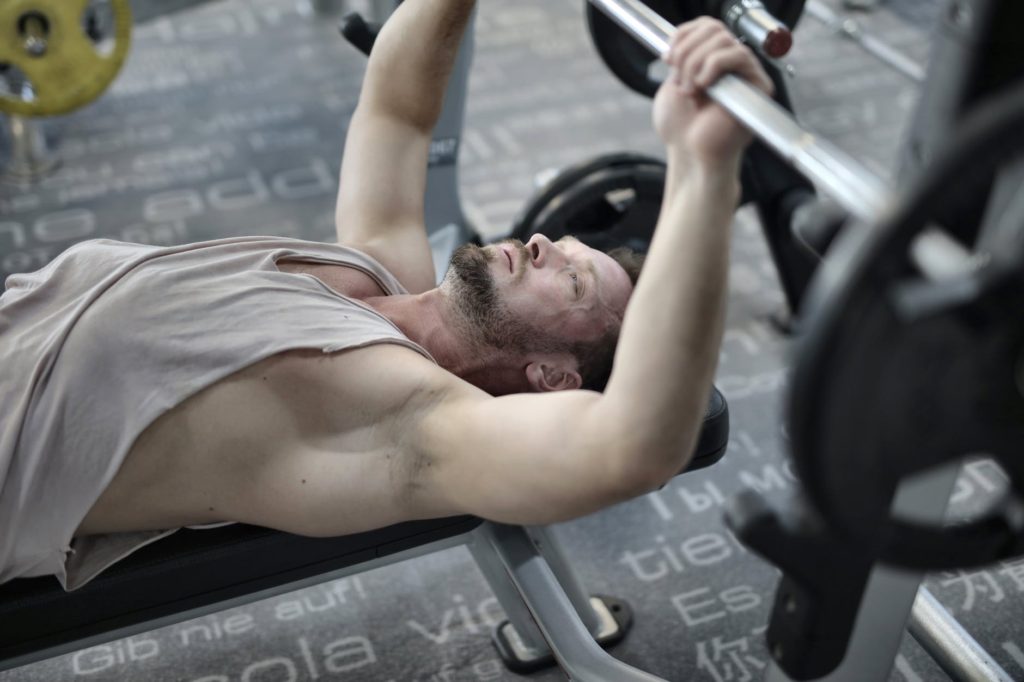
Table of Contents
Introduction
Are you trying to figure out How To Increase Your Max Bench?
You’ve just discovered the right guide for that but have it in the back of your mind that you’ll have to work hard to get there. If you’re ready, you will get terrific tips out of this guide.
Whether you think that the bench press is the king of all exercises or the most overrated movement at the gym, we can all agree that, to some extent, the bench is still the norm when it comes to flaunting powerlifting prowess.
The bench press is one of the first exercises most guys drift to at the gym. There’s something about pushing an iron-filled bar across their chest that makes many men feel manly.
Feeling manly is not the only factor that makes the bench press so relevant. It is also undoubtedly one of the best compound exercises.
With a simple movement, you get an excellent workout for your back, chest, and arms. Bench pressing also works other muscles to a lesser extent, including the legs.
Regardless of your fitness goals, learning to bench press is essential. Whether you want to build lean muscles, gain mass, or stay fit, being able to bench press correctly helps!
However, many people don’t make the gains they deserve, and they struggle to add weight to the bar and improve their best.
Learning how to increase your max bench is not as simple as it sounds. There are many different factors involved in this essential exercise.
With the tips below, you will see your desired results in no time.
Tip #1 – Be Ready MENTALLY!
Most workout freaks have a playlist of motivational songs.
Without even arguing about it, we all know that music helps us stay in a good mood. However, it is possible to go further in this concept to achieve even more important results.
A entire blog post could probably be written about the importance of music during workouts, but most of it boils down to two factors: visualization and concentration.
Concentration is the capability to stay focused on a particular task. Research has shown that concentration leads to more consistent performance in athletic competitions.
A good additional tip for this is to imagine the results you desire. Do not imagine the pain that you’ll have to go through, imagine yourself at the finish line.
______________________________________________________________________________

______________________________________________________________________________
Tip #2 – Warm Up Properly
Instead of heading to the cardio area for a relaxed jog, head to the weight room and warm up with the bench press.
This not only warms up the specific muscles that you want to train but it helps to prep your body for the weight and movement that you will be using.
Here’s How It Should Be Done:
- 10 reps with the bar
- 1 Min Break
- 7 reps with 50% working weight
- 1 Min Break
- 5 reps with 70% working weight
- 1 Min Break
- 2 reps with 90% working weight
- 1 Min Break
- First set
That’s it! So, if you are moving to a shoulder or triceps exercise after the bench press, it is no longer necessary to warm up because you will be very warmed up at that point.
However, if you go from the bench press to a back or leg exercise, warm up again for that part of the body.
Tip #3 – Position Yourself Properly
In order to maximize your bench, it’s vital to ensure that you are properly positioned before you start lifting. Form is absolutely vital.
- Stand on the bench in such a way that your eyes are positioned beneath the bar
- Get yourself anchored to the bench by fixing the head, glutes and shoulder blades to the bench, creating a solid base to release weight and a natural arch in the back.
- Keep the natural arch behind your back, keep your shoulder blades pinned to the bench, and your chest high.
- Place your feet below the knees and focus on pushing them towards the ground to create a solid base from which to push.
- Start With Un-racking
- Squeeze your abs and glutes for stability
On the bench, it is prevalent for people to collapse the lower back and drop their chest when weight is lowered.
This deprives them of their stable base, only for them to try to readjust their position while trying to lift the weight. This inevitably causes injury and a decrease in power output.
Planting your feet is one of the most neglected parts of positioning, as people often choose to overlook what the legs do when the legs can have a big impact on your ability to lift heavier weights.
Get your position right for a better bench and less risk of injury.
Tip #4 – Don’t Stretch Before You Lift
Stretching before a workout has long been considered a must, but research now shows that it’s not optimal for weight performance.
One study proves that static stretching before weightlifting results in a significant reduction in strength, even in stretches lasting 45 seconds or less, and it may also decrease strength in upper and lower body exercises in both trained and untrained people.
Next time you hit the gym, avoid stretching until after you’ve finished your work out, if you want to be your best.
Tip #5 – Avoid The Smith Machine
If you mainly lift weights at home, you may not be familiar with the Smith machine.
This machine is suitable for beginners, but does not produce the same level of muscle effort that can be achieved by using free weights.
Research made this very clear: Smith machines are not as effective as free weights. The Smith machine could be compared to bicycle training wheels. They are good only for those who need them.
Of course, the machine does a good job of keeping a lift perfectly straight, but it also makes the job easier, which, ultimately, is counterproductive.
Using a Smith machine rather than free weights will certainly decrease your workout results. This is because the muscles simply don’t work as hard when the machine supports them.
Sudies indicate that the difference in effort can reach as high as 43%. This is a big difference, so avoid the Smith machine if you are looking to increase your max bench.
______________________________________________________________________________

______________________________________________________________________________
Tips #6 – Strengthen Your Weaker Muscles
When you do the bench press, the main engine is the chest, and when you lift this, you should try to create that mind-muscle connection and focus on how your pectorals feel during the movement.
However, these are not the only muscles that work; triceps and shoulders are also utilized as support muscles during lifting.
Since your muscles are smaller than your chest, you will find that you will reach a point where the triceps and shoulders begin to fatigue in front of your chest, which will prevent your ability to lift more weight.
It is at this point that you want to start building the strength of these secondary muscles to improve your ability to contribute to the max bench.
Good workouts to improve the strength of the shoulders and triceps are heavy, low rep lifts:
- Overhead press
- Close grip bench press
Then, mixed with a small moderate load, use a moderate rep work of the following:
- Front raises
- Triceps extensions
Tip #7 – Progressive Overload
Progressive overload is the idea of gradually increasing the amount of stress you exert on the muscles. You can achieve this in several ways, as detailed below.
This principle cannot be emphasized enough when it comes to increasing strength in any area. You must challenge your chest continually if you expect to increase your max bench.
It is also essential to keep an eye on:
- The number of sets you do.
- Quantity of reps you do per set.
- The amount of weight you are using.
- The rest periods between sets.
Many people lack gains and progress because they do not apply progressive overload. To make matters worse, some do not keep an eye on, and properly track their metrics.
When you ascend the ladder, these little weights will be your best friends. I’m talking about those beautiful 2.5-pound weights.
Yes, use them to climb the ladder slowly on your quest to increase your max bench. It is highly recommended to use increments of less than 5 pounds. You can get small weights of anywhere from ¼ pound to 1 pound.
______________________________________________________________________________

______________________________________________________________________________
Tip #8 – The Right Grip
For safety reasons, you should probably avoid “false” or thumbless grip (also called a “suicide grip”) when you are on the bench; you should place the bar on the heel of your hand (directly over the top of your wrist ).
Note, that if you place the bar closer to the base of your fingers or in your palm, your wrist will bend back.
If the bar rests towards the heel of your hand, you can maintain a straighter wrist position and the forearm will line up directly under the bar, giving you more strength and stability.
Some research shows that different grip widths emphasize the bench on different muscles. In fact, changing the width of the grip is a great way to help overcome fixation points by continuing to train the bench.
For example, a wider grip (just off the shoulders) puts more emphasis on the chest, while a tighter grip will work out the triceps.
Tip #9 – Use the Dumbbell Bench Press
Sometimes, when people focus on increasing their max bench, they end up neglecting the use of dumbbells, which is quite understandable.
Dumbbell movements tend to put more stress on the chest and less on the triceps, which is more prominent at the top of the rep, where you can squeeze the dumbbells for an extra pump on your pecs. Use this to your advantage if your triceps are fairly strong, but your chest is lagging.
Dumbbell movements tend to be a good fitness teacher for your general pressure movements.
Utilizing dumbbells force the coordinating muscles to participate much more, which can help improve coordination and confidence in your bench press.
Tip #10 – Breathe The Right Way
Too often, people who neglect their breathing rate when they are on the bench, often choose to hold their breath for reps, or simply inhale and exhale without thinking about how it might affect their performance.
The truth is, breathing correctly can help stabilize your lift and allow you to lift heavier weights.
- Inhale after un-racking the bar and start bringing the bar to your chest.
- Hold your breath to provide stability and rigidity when the bar touches your chest.
- Forcefully exhale while performing the concentric part of the movement to return the bar to its original position.
- Once the lockout position has been reached, inhale again when the next repetition begins
- Continue until you have finished your set
If you implement the correct breathing, you will find that you can produce more force during concentric movements and feel more stable when lifting.
Summary
Hopefully those tips will empower you to maximize your bench press numbers! If you start implementing these tactics and strategies, you’ll start to see improvements in no time.
Learning to increase your max bench press is more complicated than it looks. You can simply lie down and push weight on your body and call it good. However, you will quickly discover that it is neither effective nor safe for your body.
Deliberately approaching the bench with the information in this article will not only ensure that you see results quickly, but will also enable you to consistently maintain your workouts through quick and healthy recovery periods for months to come.
______________________________________________________________________________

______________________________________________________________________________
Resources Cited:
https://journals.humankinetics.com/doi/abs/10.1123/tsp.22.3.288
https://www.ncbi.nlm.nih.gov/pubmed/22316148
https://www.ncbi.nlm.nih.gov/pubmed/20093960
